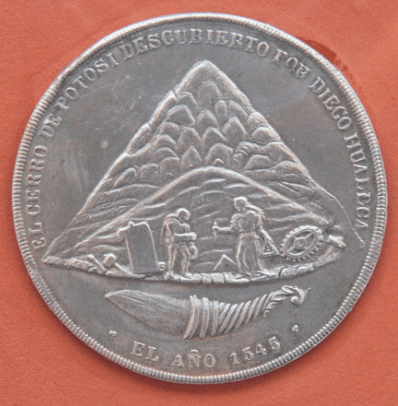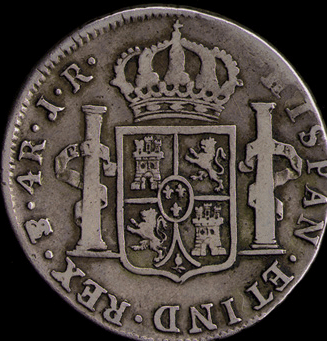Juan Jose Toro writes in El Deber:
Potosi and the coins
 Potosi is known to habe been one of the most important cities of the Colony with its Cerro Rico [rich mountain]. True but insufficient. To understand what was Potosi, would have to say it was, in its time, the sum of London and New York. What happened there gravitated in world politics and therefore its economic movement determined prices and trends.
Potosi is known to habe been one of the most important cities of the Colony with its Cerro Rico [rich mountain]. True but insufficient. To understand what was Potosi, would have to say it was, in its time, the sum of London and New York. What happened there gravitated in world politics and therefore its economic movement determined prices and trends.
A little detail is known, for example, that the US dollar, now a global movement, was born in Potosi. This was ratified by Glenn Stephen Murray Fantom, American historian and numismatist who won the Europa Nostra Award in 2009.
 In perfect Spanish, as living in Segovia (Spain), Murray explained to me that the coins minted in the second Mint of Potosi were circulating in most countries known as ‘civilized’ in colonial times and, due to its high silver content, were accepted without regard to any transactions. I did not know, and expert enlightened me about it, is that potosino coins circulated as legal currency in the United States until 1857 because that country, very young then, did not have enough money to coinage or metal backing that would have allowed them to print banknotes.
In perfect Spanish, as living in Segovia (Spain), Murray explained to me that the coins minted in the second Mint of Potosi were circulating in most countries known as ‘civilized’ in colonial times and, due to its high silver content, were accepted without regard to any transactions. I did not know, and expert enlightened me about it, is that potosino coins circulated as legal currency in the United States until 1857 because that country, very young then, did not have enough money to coinage or metal backing that would have allowed them to print banknotes.
The situation lasted until the discovery of gold and silver in California. From the year concerned, banks such as Manhattan and Philadelphia began printing money, but people accustomed to the Potosi currency, were not using those baknotes in their transactions. As a result, banks were forced to print money that included images of the Potosi coins, as its value; ie a coin on the dollar bill, five in the five and ten on ten.
 It is therefore not surprising that the dollar symbol (the ‘S’ cross vertically by two parallel lines) originated in the Potosi coins, as these were the anagram of Potosi in one figure and its sides were the pillars of Hercules . In the anagram it protruded the ‘S’ to which the columns were placed together.
It is therefore not surprising that the dollar symbol (the ‘S’ cross vertically by two parallel lines) originated in the Potosi coins, as these were the anagram of Potosi in one figure and its sides were the pillars of Hercules . In the anagram it protruded the ‘S’ to which the columns were placed together.
Truths like these, and others still hidden, will be known and disseminated at the international convention of historians and numismatists to be held in October at the Villa Imperial [Potosi]. The official presentation is on Thursday [02/25/2016] in the cultural courtyard of the Ministry of Culture, in La Paz. It will be worth a Potosi [in Spanish “vale un Potosi” was an old saying that meant “to be of great value”], to attend these deliberations of a meeting that begins this February.

I love this article, but am confused. Does the first mint building still exist? Does anyone have a photo of the building as it appears today?
The first mint house as a building exists to date … It is going to become a museum. No photos that I could find tho…
I believe the the transfer of one public institution to the other, let alone the several decades that went by, was what took it SO long, hopefully now that will be expedited.
I believed, it was only the two columns from the code of arms of Potosi that ended in the $ sign ,,. but, in any case it is unquestionable the relevance and importance of the Cerro Rico’s silver in the world! Thank you for your input.